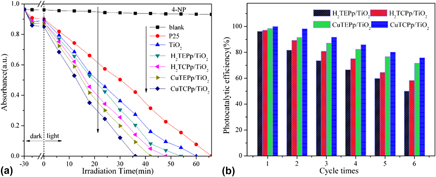Crossref Citations
This article has been cited by the following publications. This list is generated based on data provided by
Crossref.
Lu, Guifen
Bao, Li
Hu, Xinying
Liu, Xudong
and
Zhu, Weihua
2018.
Synthesis, spectroscopic characterization and photocatalytic properties of corrole modified GPTMS/TiO2 nanoparticles.
Inorganic Chemistry Communications,
Vol. 98,
Issue. ,
p.
165.
Zhao, Fenfen
Rong, Yuefei
Wan, Junmin
Hu, Zhiwen
Peng, Zhiqin
and
Wang, Bing
2018.
MoS2 quantum dots@TiO2 nanotube composites with enhanced photoexcited charge separation and high-efficiency visible-light driven photocatalysis.
Nanotechnology,
Vol. 29,
Issue. 10,
p.
105403.
Mahto, Madhusudan Kr.
Samanta, Dipanjan
Konar, Suraj
Kalita, Himani
and
Pathak, Amita
2018.
N, S doped carbon dots—Plasmonic Au nanocomposites for visible-light photocatalytic reduction of nitroaromatics.
Journal of Materials Research,
Vol. 33,
Issue. 23,
p.
3906.
Song, Yiming
Li, Jun
and
Wang, Chen
2018.
Modification of porphyrin/dipyridine metal complexes on the surface of TiO2 nanotubes with enhanced photocatalytic activity for photoreduction of CO2 into methanol.
Journal of Materials Research,
Vol. 33,
Issue. 17,
p.
2612.
Schneider, Johannes
Berger, Thomas
and
Diwald, Oliver
2018.
Reactive Porphyrin Adsorption on TiO2 Anatase Particles: Solvent Assistance and the Effect of Water Addition.
ACS Applied Materials & Interfaces,
Vol. 10,
Issue. 19,
p.
16836.
Li, Yuxin
Fu, Rong
Wang, Xiangdong
and
Guo, Xiaoling
2018.
Preparation of core–shell nanostructured black nano-TiO2 by sol–gel method combined with Mg reduction.
Journal of Materials Research,
Vol. 33,
Issue. 24,
p.
4173.
Yan, Xuehua
Yuan, Xiaoxue
Wang, Jinging
Wang, Qiong
Zhou, Chen
Wang, Dongfeng
Tang, Hua
Pan, Jianmei
and
Cheng, Xiaonong
2019.
Construction of novel ternary dual Z-scheme Ag3VO4/C3N4/reduced TiO2 composite with excellent visible-light photodegradation activity.
Journal of Materials Research,
Vol. 34,
Issue. 12,
p.
2024.
Kobasa, I. M.
Kondratyeva, I. V.
and
Kropelnytska, Yu. V.
2019.
Sensitization of TiO2 by the symmetric cationic polymethine dye for the photocatalytic reduction of methylene blue.
Functional Materials Letters,
Vol. 12,
Issue. 03,
p.
1950038.
Zhao, Fenfen
Ke, Weiquan
Peng, Zhiqin
Wan, Junmin
and
Hu, Zhiwen
2019.
High‐Efficient Visible‐Light Response and Photoelectrochemical Performance of Nanotube‐Sheet Composite Fabricated by Ultrathin Porphyrin Nanosheet and TiO2 Nanotubes.
ChemistrySelect,
Vol. 4,
Issue. 3,
p.
941.
Yu, Chengtao
Zhang, Jingyi
Yang, Hexu
Zhang, Ling
and
Gao, Yu
2019.
Enhanced photovoltaic conversion efficiency of a dye-sensitized solar cell based on TiO2 nanoparticle/nanorod array composites.
Journal of Materials Research,
Vol. 34,
Issue. 07,
p.
1155.
Ding, Xiaodong
Wang, Wei
Zhang, Ao
Zhang, Lishan
and
Yu, Dan
2019.
Efficient visible light degradation of dyes in wastewater by nickel–phosphorus plating–titanium dioxide complex electroless plating fabric.
Journal of Materials Research,
Vol. 34,
Issue. 6,
p.
999.
Gonçalves, Bruno S.
Silva, Lucas M.C.
de Souza, Tarcizo C.C.
de Castro, Vinícius G.
Silva, Glaura G.
Silva, Bruno C.
Krambrock, Klaus
Soares, Renata B.
Lins, Vanessa F.C.
Houmard, Manuel
and
Nunes, Eduardo H.M.
2019.
Solvent effect on the structure and photocatalytic behavior of TiO2-RGO nanocomposites.
Journal of Materials Research,
Vol. 34,
Issue. 23,
p.
3918.
Guo, Xingyu
Li, Xiangqing
Qin, Lixia
Kang, Shi-Zhao
and
Li, Guodong
2019.
A highly active nano-micro hybrid derived from Cu-bridged TiO2/porphyrin for enhanced photocatalytic hydrogen production.
Applied Catalysis B: Environmental,
Vol. 243,
Issue. ,
p.
1.
Zammouri, Lobna
Aboulaich, Abdelhay
Capoen, Bruno
Bouazaoui, Mohamed
Sarakha, Mohamed
Stitou, Mostafa
and
Mahiou, Rachid
2019.
Synthesis of YAG:Ce/ZnO core/shell nanoparticles with enhanced UV-visible and visible light photocatalytic activity and application for the antibiotic removal from aqueous media.
Journal of Materials Research,
Vol. 34,
Issue. 08,
p.
1318.
Li, Changxin
Liu, Yan
Zhang, Yanzong
Long, Lulu
Shen, Fei
Yang, Gang
Zhang, Xiaohong
He, Yan
Wang, Lilin
and
Deng, Shihuai
2019.
Electro-assisted ammonium persulfate activation to promote the introduction of N and S into TiO2 film: Enhancing its photoelectrocatalytic performance under solar.
Journal of Materials Research,
Vol. 34,
Issue. 20,
p.
3573.
Luciani, Giuseppina
Imparato, Claudio
and
Vitiello, Giuseppe
2020.
Photosensitive Hybrid Nanostructured Materials: The Big Challenges for Sunlight Capture.
Catalysts,
Vol. 10,
Issue. 1,
p.
103.
Zhang, Zuowei
Hao, Hongshun
Jin, Shanshan
Hou, Yunxia
Hou, Hongman
Zhang, Gongliang
Bi, Jingran
Yan, Shuang
Liu, Guishan
and
Gao, Wenyuan
2020.
Novel Tm3+/Yb3+–co-doped Bi2MoO6: Synthesis, characterization, and enhanced photocatalytic activity under visible-light irradiation.
Journal of Materials Research,
Vol. 35,
Issue. 3,
p.
312.
Chen, Jiabing
Lu, Youluan
Huang, Leshu
Shi, Zhen
Zheng, Yin
Song, Xinjian
Wu, Chenyi
and
Wu, Zaikun
2020.
Photocatalytic Self-Cleaning Electrochemical Sensor for 4-Nitrophenol detection.
International Journal of Electrochemical Science,
Vol. 15,
Issue. 6,
p.
5179.
Lin, Chunling
Gao, Yifeng
Zhang, Jiaoxia
Xue, Dan
Fang, Hua
Tian, Jiayong
Zhou, Chunli
Zhang, Chanjuan
Li, Yuqing
and
Li, Honggang
2020.
GO/TiO2 composites as a highly active photocatalyst for the degradation of methyl orange.
Journal of Materials Research,
Vol. 35,
Issue. 10,
p.
1307.
Linley, Stuart
and
Thomson, Neil R.
2021.
Environmental Applications of Nanotechnology: Nano-enabled Remediation Processes in Water, Soil and Air Treatment.
Water, Air, & Soil Pollution,
Vol. 232,
Issue. 2,
